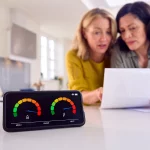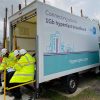First BT Fibre-to-the-Remote-Node FTTrN Broadband Trial Set for Q4 2014
The Superfast North Yorkshire project in England has confirmed to ISPreview.co.uk that its first trial of BT’s new superfast Fibre-to-the-Remote-Node (FTTrN) broadband technology, which has the potential to deliver much faster and more stable speeds than the traditional Fibre-to-the-Cabinet (FTTC) service, is now being implemented and will be “ready to accept customer orders” in late 2014.
The FTTrN trials, which will also be taking placing in other locations such as London’s Shoreditch area and a small part of Bedford town in Bedfordshire among others, first came to light in March 2014 (here) and hold more than a passing similarity to the Fibre-To-The-Distribution-Point (FTTdp) approach that we’ve reported on before.
Advertisement
At present most of BT’s national superfast broadband (24-30Mbps+) roll-out involves the use of ‘up to’ 80Mbps capable hybrid-fibre FTTC, with previous little 330Mbps pure fibre optic Fibre-to-the-Premises (FTTP). The latter would cost tens of billions more and many additional years to roll-out across the United Kingdom, which Openreach understandably deems to be far too expensive.
By comparison FTTC is considerably cheaper, if admittedly a lot slower, and able to reach a much larger proportion of people in a shorter space of time because it only runs the new fibre optic cable up to your local street cabinet. After that the existing copper line infrastructure (between your home and the cabinet) is simply re-used via VDSL2 technology (like ADSL but faster over the shorter distance of remaining copper).
But for some deeper rural areas, and even a few urban locations, FTTC might not be the most cost effective approach and so BT intends to trial FTTrN.
What is FTTrN?
In simple terms FTTRN will work like FTTC, except that instead of taking the fibre optic cable to your local street cabinet it will run the fibre all the way up to smaller and lower power remote nodes (e.g. similar to the ECI Hi-Focus MiniCAB 64V perhaps), which can be positioned on nearby telegraph poles, inside manholes / NGA aggregation nodes or at a variety of other locations.
Advertisement
The nodes themselves would effectively act like tiny street cabinets and distribute the broadband service via VDSL2 using the remaining run of copper cable to your home or office. Several advantages may exist with this approach, such as the ability to avoid building an expensive FTTC cabinet, with all its cosmetic, power supply and planning complications, and the potential for a reverse power setup; although it could also be remote powered (depending upon the hardware used).
It’s possible that BT may experiment with more than one type of node and in the past they’ve mooted the idea of a reverse power approach, although this may create problems. On a traditional copper line the wire is usually remote powered by BT, which is why you can plug a basic non-battery handset in and it works even when your local electricity supply is cut (unless BT’s backup has also failed).
By comparison a reverse power approach means that the remote node would instead be powered from the customer’s premise. The cost to the end-user is likely to be fairly small (estimates vary from a few watts to 20-30W, depending upon the number of lines and how it’s managed) and this helps to make superfast broadband significantly cheaper to deploy, although equally if you suffer a power cut then your phone and broadband would also be disconnected (solutions for this may exist via a smaller backup battery).
Take note that ECI’s older minicabs, which Openreach has talked about using in the past and look set to form part of the initial trial (it’s often described to us in a way that sounds distinctly more ‘remote’ than ‘reverse’ powered), only support the more traditional remote power setup. Meanwhile other companies, such as Alcatel-Lucent, sell similar micro-nodes that support both types of power (here).
Advertisement
In addition, FTTrN also has the potential to help shorten the remaining run of copper cable than might otherwise be possible in a traditional FTTC setup. By doing this you not only put more homes within reach of the top 80Mbps speed (shorter copper = less interference), but you also give them the potential to benefit from even faster 100-200Mbps speeds in the future (i.e. when combined with Vectoring to tackle crosstalk interference and a 30a profile – 30MHz of spectrum vs 17.66MHz with the current 17a profile).
Going further there’s also the possibility of future G.fast (aka – FTTC2) technology being used to push some homes nearer to Gigabit speeds, although that’s still someway off and much would depend upon how close the fibre can be taken to your home. G.fast loses many of its advantages after just a few hundred metres, although that’s still enough to benefit a several million premises but experiences will dramatically vary.
The North Yorkshire Trial
BT originally indicated that a further 5,000 premises could potentially be uplifted to above 25Mbps by using FTTrN in North Yorkshire, although the trial itself will involve a significantly smaller number of premises. A spokesperson for SFNY told ISPreview.co.uk, “As the technology is engineered around serving small communities the number of premises served by each node will be low (when compared to current FTTC deployment).”
In this instance, local planning for the trial shows that there will be circa 20 premises served by the introduction of a node (we’re informed that there may also be some home-based businesses running from these premises). At the time of the first reveal BT told the local authority that they intended to conduct their pilot within the market town of Leyburn (Richmondshire), although SFNY advised us that this had been “incorrectly reported” (note: it clearly appeared in their own meeting minutes).
SFNY later clarified to ISPreview.co.uk that officially they could only confirm that Richmondshire is the right district and “the exact location of the trial will be disclosed in due course“. Indeed we’re further told that the trial will be conducted in a “remote village“, which could mean one of Leyburn’s closest outlying villages like Harmby, Wensley or Bellerby.
In any case we’re informed by SFNY that their local trial is now officially within the implementation phase (this includes the deployment of both fibre optic lines and power) and it’s anticipated to be ready to accept customer orders during late 2014. Once it’s known whether FTTRN technology works then it could be consolidated into the projects Phase 3 planning for official deployment.
It should be stressed that FTTrN won’t be viable for every location, but it does have the potential to bring superfast broadband to many more premises than currently possible and within the existing Broadband Delivery UK (BDUK) programme budget. Quite how widely it will be adopted has yet to be determined and that’s part of what the trials will help BT to discover.
Mark is a professional technology writer, IT consultant and computer engineer from Dorset (England), he also founded ISPreview in 1999 and enjoys analysing the latest telecoms and broadband developments. Find me on X (Twitter), Mastodon, Facebook, BlueSky, Threads.net and Linkedin.
« EE Expands 4G Mobile Broadband Network to 75 Percent of the UK


















































Comments are closed